Executive Summary
Cobalt Sentinel Security, LLC (d/b/a Cobalt Security) is a Texas-based private security firm in Dallas serving the Dallas–Fort Worth metro, with Austin and Houston on deck in Year 2. We provide unarmed and armed standing guards, mobile patrol and alarm response, event security, site risk assessments with post-order drafting, and optional remote video monitoring through a SOC partner. This is an investor-ready, lender-friendly security company business plan—straight to the point, numbers first.
Our customers are pragmatic: property and facility managers who need lobby coverage and after-hours patrols, retailers fighting shrink, distribution and industrial sites that can’t afford downtime, and event organizers who want crowd control without drama. They judge us on staffing reliability, clean incident reporting, and whether we actually hit the SLAs we promise. Fair enough—that’s exactly what we measure.
Why we tend to win: we train like it matters (state requirements plus de-escalation, report writing, emergency procedures); we run on a modern tech stack (guard-tour with GPS breadcrumbs, geo-fenced timekeeping, photo/video incident logs, a client portal with live dashboards); and we keep supervisors visible on nights and weekends (target ratio 1:20 on higher-risk sites). Pricing is built from the unit economics up—bill rate follows risk class and shift, not wishful thinking.
Unit economics in plain English. For a typical commercial post, an unarmed guard billed at $29.00/hr carries a loaded cost around $22.54/hr (pay, taxes/Workers’ Comp, benefits, uniforms/equipment, scheduling/overhead), leaving $6.46/hr or about 22.3% gross margin. An armed post billed at $40.00/hr lands near a $30.63/hr loaded cost and $9.37/hr margin (~23.4%). Across the mix, we model a blended contribution of roughly $7.10/hr.
| Service | Bill Rate | Loaded Cost | Gross Margin | GM % |
|---|---|---|---|---|
| Unarmed Standing Guard | $29.00/hr | $22.54/hr | $6.46/hr | 22.3% |
| Armed Standing Guard | $40.00/hr | $30.63/hr | $9.37/hr | 23.4% |
Break-even, no mystique: steady-state fixed overhead sits near $60,000/month. With a blended contribution of about $7.10/hr, we need roughly 8,450 guard-hours/month to clear break-even. A 40-hour weekly post yields ~173 billable hours per month, so about 49 posts do the job. We target break-even by Month 8 on a disciplined ramp.
| Metric | Year 1 | Year 2 | Year 3 |
|---|---|---|---|
| Revenue | $1.9M | $4.1M | $6.3M |
| Gross Margin % | 24% | 25% | 26% |
| EBITDA % | 8% | 10% | 12% |
| Ending Weekly Hours | 1,000 | 2,100 | 3,100 |
| DSO (days) | 45 → 38 | 35 | 33 |
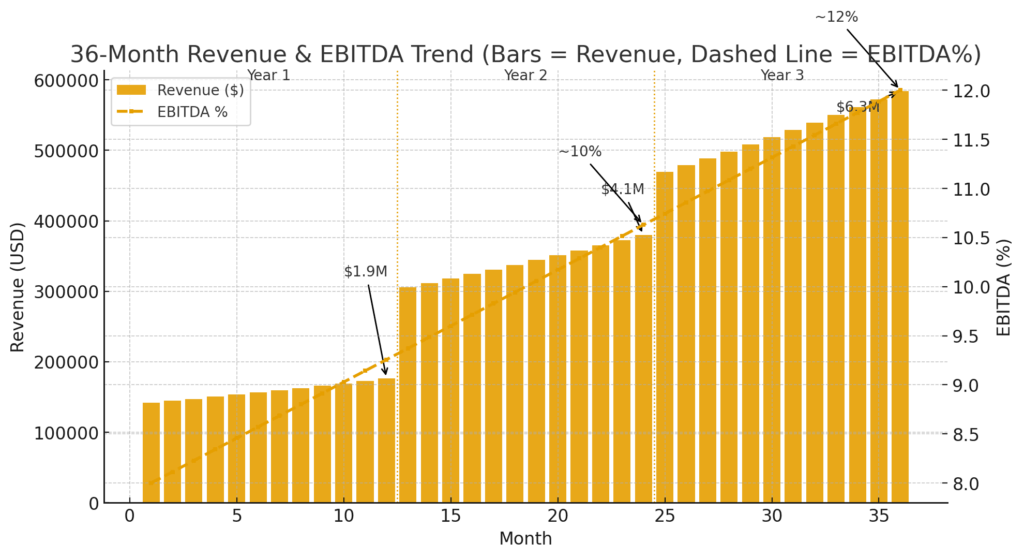
Funding ask: $650,000. The use is practical—working capital for payroll timing and AR float ($350k), six patrol vehicles with upfit ($120k), insurance premia and collateral ($60k), recruiting/training/licensing and gear ($80k), software ($20k), and a modest contingency ($20k). It’s a straightforward path to staffing 50+ posts and standing up patrols without cash whiplash. If you came here looking for a clean security guard company business plan sample with real numbers, that’s what this is.
Company, Licensing & Compliance
We keep the structure simple and bankable. Cobalt Sentinel Security, LLC is a Texas LLC (convertible to Inc. if the cap table demands it) operating under NAICS 561612. Headquarters: 1200 Trinity Commons Dr, Suite 410, Dallas, TX 75207. The trade name is Cobalt Security. Nothing exotic—just the right scaffolding to run a private security services business plan without surprises.
Insurance is sized for real-world contracts: General Liability $1M/$2M, Workers’ Comp (statutory), Auto for the patrol fleet $1M CSL, Professional/E&O $1M, and an Umbrella at $5M. Surety bonding in the $10k–$50k range is available if a client or jurisdiction requires it. We issue client-specific COIs with additional insured and waiver of subrogation as needed. In other words, the coverage investors expect—no corners cut.
Licensing starts with the Texas Department of Public Safety’s Private Security Program for the company license, plus Level II (unarmed), Level III (armed), and Level IV (PPO) credentials for officers where posts require them. Renewals live on a centralized calendar. When we cross state lines later, we’ll secure agency licenses, appoint qualifying managers where required, and register for state taxes and unemployment—do it once, do it right.
Hiring & background checks follow an FCRA-compliant path: a standalone disclosure and written authorization up front; a reputable CRA for criminal history, employment verification, and, when job-related, MVR/credit for armed or driving roles; pre-adverse and adverse action steps with the proper notices; and tight data retention and destruction schedules. It’s not glamorous, but it protects candidates, clients, and us.
Safety is built on OSHA fundamentals: site-specific job hazard analyses, de-escalation and emergency procedures in training, BBP basics where relevant, and heat/cold stress protocols for patrol. Incidents are reported within 24 hours, followed by root-cause analysis and corrective actions. We maintain OSHA 300/301 records when thresholds apply. The goal is simple—send people home in the same shape they arrived.
If a contract is federal or otherwise covered, we price under the Service Contract Act (SCA) using the applicable Wage Determination: base wage plus health & welfare fringe accrue in cost of goods, vacations and holidays are tracked, postings go up on site, and we request equitable adjustments if determinations change. For airports and municipalities, we mirror the local prevailing wage rules. It keeps pricing honest and margins intact.
Use-of-force and equipment. Armed officers qualify at hire and on the prescribed cycle; firearms are stored, issued, and transported under written policy; any critical incident is reported within 12 hours and triggers administrative leave pending review. Less-lethal tools are carried only with training and explicit site approval. If body-worn cameras are used, retention and access are privacy-aware and contractual.
Data, reporting, privacy. Clients get a portal with least-privilege roles, encryption in transit and at rest, and clear retention schedules for incident reports, video, and logs. If there’s ever a breach, we notify per state law. No surprises, no black boxes.
| Area | Control | Cadence | Owner |
|---|---|---|---|
| Company & Officer Licenses | Renewals; roster audits | Quarterly; per-state cycles | Compliance Lead |
| Training & Qualifications | Level II/III/IV; site drills | At hire; annual/biannual | Training Lead |
| FCRA Files | Disclosure/authorization; adverse action | Per candidate | HR |
| OSHA | JHAs; incident logs; toolbox talks | Monthly; post-incident | Ops Manager |
| SCA / Prevailing Wage | WD mapping; accruals; postings; true-ups | At award; quarterly | Finance & Compliance |
| Insurance | COIs; limits review | Per contract; annually | Controller |
| Fleet & Patrol | MVR checks; maintenance logs | At hire; quarterly | Fleet Supervisor |
Bottom line: this company, licensing, and compliance posture gives lenders and investors what they expect from a serious business plan for a security service company—and gives operations the guardrails to run cleanly day to day. It’s practical, it’s auditable, and it won’t slow the field down.
Market & Competitive Landscape
We’re launching into a pragmatic, outsourced market: property and facility managers who want predictable lobby coverage, retailers fighting shrink, and logistics operators who can’t risk idle docks. Dallas–Fort Worth is a good sandbox—dense Class A/B office, sprawling retail, and one of the largest industrial footprints in the U.S. The story is simple: most end-buyers prefer to outsource security to avoid payroll risk, training overhead, and compliance liabilities. Our job is to be reliably better at staffing, supervision, and reporting than their current provider—without playing race-to-the-bottom on price.
Launch Segments & Demand Drivers
We focus on three steady segments at launch—property management, retail, and logistics/warehousing—and selectively take healthcare/events when the fit is right. Demand is driven by shrink, insurance requirements, tenant expectations, and after-hours risk in large, spread-out assets.
- Property Management (Office/Class A/B): lobbies, docks, rovers; tenants expect a visible presence and crisp incident logs.
- Retail (Big-box/Malls): loss prevention posture, opening/closing, parking-lot presence; seasonal spikes.
- Logistics/Warehousing (>100k sq ft): gate control, yard checks, trailer seals; nights and weekends dominate hours.
- Selective Healthcare & Events: access control and crowd management where de-escalation skills matter more than bravado.
TAM–SAM–SOM (Dallas–Fort Worth) — Transparent, Bottom-Up
We size the market from guard-hours, not wishful thinking. Assumptions are conservative and editable in the model.
| Segment | Estimated Sites | Avg Posts/Hrs | Weekly Guard-Hours |
|---|---|---|---|
| Office (Class A/B) | 1,200 | ~1.6 posts · 16h/day | 134,400 |
| Retail (Big-box/Malls) | 1,400 | ~1.2 posts · 12h/day | 117,600 |
| Warehouses (>100k sq ft) | 1,800 | ~0.8 posts · 8h/day | 115,200 |
| Hospitals/Large Clinics | 120 | ~3 posts · 24/7 | 20,160 |
| Event Venues/Stadiums | 25 | ~1,200 hrs/year ea. | ~577 |
| Total | 4,545 | — | ~387,937 |
TAM math: ~387,937 guard-hours/week × 52 ≈ ~20.97M hours/year. With a Year-1 blended bill rate of roughly $31/hr, the TAM ≈ $649M for the DFW area (broad, all segments).
| Layer | Definition | Hours/Year | Bill Rate | Market Value |
|---|---|---|---|---|
| TAM | All guarding hours across segments above | ~20,972,724 | $31/hr | ~$649M |
| SAM | Launch segments (office/retail/warehousing) within a 45-min radius, outsourced share only | ~10,549,656 | $31/hr | ~$327M |
| SOM (Yr-3) | Our obtainable share at ~3,100 weekly hours | ~161,200 | $31/hr | ~$5.0M |
Assumptions (documented): outsource rate ~65% in target segments; 85% of sites fall inside a 45-minute dispatch radius; bill-rate mix centers on unarmed/armed standing with light patrol. We’ll tune these after the first 10 signed sites.
Outsourcing Dynamics (Why Buyers Switch)
Buyers rarely switch for a few cents on the bill rate; they switch when posts go unfilled, reports are late, or supervisors are ghosts on nights/weekends. Compliance and insurance hygiene matter more each year, especially for multi-tenant assets and national retailers. The short version: consistency beats charisma.
- Top buying factors: schedule fill rate, incident reporting quality, response times, and supervisor presence.
- Deal friction: long AR cycles, sloppy COIs, weak training records, or unclear post orders.
Competitors & Our Positioning
DFW has everything from global integrators to sharp local shops. The globals bring scale and breadth; locals bring attention. We slot in as the operator’s operator: supervisor-heavy where risk justifies it, and transparent on KPIs so clients never wonder what they’re paying for.
- Global/majors: nationwide coverage, easy to staff large footprints, but often thin on site-level attention.
- Regional & local SMBs: strong relationships, sometimes uneven QA and reporting.
- Our edge: deeper training (de-escalation and report writing), living post orders tied to site risk, visible supervisors, and a client portal that shows fill rate, incidents per 1,000 hours, and SLA ticks in real time.
Positioning line, plain and simple: predictable staffing, clean reports, and supervisors who actually show up. That’s how we defend margin without being the cheapest—and why this market gives room for a disciplined, mid-market security company to grow.
Services, Pricing & Contracts
We sell outcomes—fewer incidents, tighter access control, cleaner reporting—not “hours on a post.” Still, the math matters. Each service line has a clear bill rate, a documented loaded labor cost, and a target gross margin per post. That’s how a security services business plan stays honest with both clients and lenders.
Service lines we actually run: unarmed and armed standing guards, mobile patrol and alarm response, event security, and site risk assessments with post-order drafting. Remote video monitoring is available through a SOC partner for sites that need eyes after midnight without adding headcount.
| Service | Typical Use | Bill Rate (Band) | Target GM % | Notes |
|---|---|---|---|---|
| Unarmed Standing Guard | Lobbies, docks, retail floors | $29–$32/hr | 22–28% | Baseline for Class A/B office; seasonal retail uses shorter shifts |
| Armed Standing Guard | High-risk posts, cash-sensitive sites | $38–$42/hr | 22–28% | Includes quals, duty gear, and higher WC rate |
| Mobile Patrol & Alarm Response | Yards, lots, lock/unlock | $65/hr or $18–$25/hit | 25–30% | 5–12 min on-site per hit; fuel & fleet baked in |
| Event Security | Venues, stadiums, conferences | $30–$40/hr (unarmed), $38–$48/hr (armed) | 20–25% | Minimums and holiday premiums apply |
| Risk Assessments & Post Orders | Pre-contract surveys | $750–$2,500/site | — | Included for contracted sites; standalone otherwise |
Loaded labor cost—what’s inside: pay rate, payroll taxes and Workers’ Comp, benefits/health & welfare (SCA fringe when applicable), uniforms & equipment, training time, and scheduling/overhead. Price follows risk class and shift, not vibes.
| Cost Component | Unarmed Example | Armed Example |
|---|---|---|
| Base Pay | $18.25/hr | $24.50/hr |
| Payroll Taxes & WC | $2.19/hr (~12%) | $3.43/hr (~14%) |
| Benefits / SCA Fringe | $1.00/hr | $1.20/hr |
| Uniforms & Equipment | $0.50/hr | $0.80/hr |
| Scheduling & Overhead | $0.60/hr | $0.70/hr |
| Total Loaded Cost | $22.54/hr | $30.63/hr |
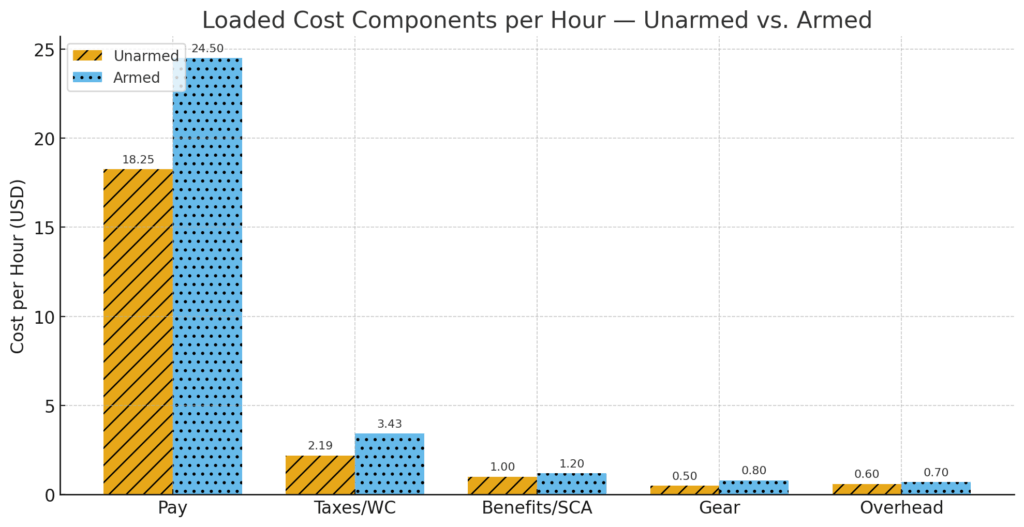
Target margin, plain talk: we aim for low-to-mid 20s gross margin on steady posts. If SCA or prevailing wage applies, we bake wage determination and fringe into COGS and protect margin with escalators. That’s how a private security company business plan keeps its promises over a 3–5 year term.
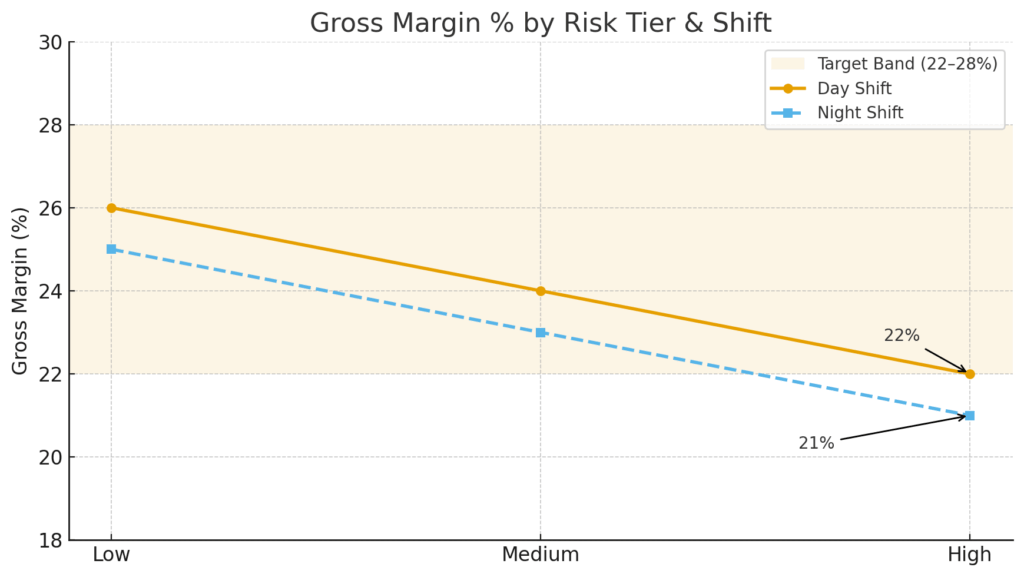
Contract terms we insist on (and why):
- SLAs/KPIs: schedule fill rate, incident reporting timeliness/quality, response times, supervisor inspections. Clients see the same dashboard we do.
- Overtime & holidays: OT billed at 1.5× unless otherwise agreed; holiday premium schedule listed, no surprises.
- Change control & escalators: rate adjustment for wage/law changes (e.g., SCA WD updates), scope changes, or sustained incident-driven staffing increases.
- Term & termination: 12-month base with 30-day convenience out (both sides), cure periods for performance, and transition cooperation—relationships survive because exits do.
- Invoicing & DSO: weekly timesheets, net-30 standard, deposits/retainers on new accounts; stop-work triggers at 60+ days. It keeps everyone disciplined.
Operations, Post Orders & Technology
Operations win or lose this business. We keep the org chart tight, supervisors visible, and the data boring—in the best way. Every site gets living post orders, a schedule that avoids chronic overtime, and QA checks that actually happen.
How we staff and supervise: field officers report to site supervisors, who report to an operations manager. On higher-risk sites we target a supervisor-to-guard ratio near 1:20; on low-risk, we widen slightly but don’t disappear. Schedules are built to minimize overtime and fatigue, with a relief pool sized at roughly 10% of active posts to cover vacations and call-offs without lighting OT on fire.
Cash discipline: security companies go sideways when payroll outruns collections. We bill weekly, reconcile AR every Friday, and escalate at 30/45/60 days. That DSO discipline is part of our operating system, not an afterthought.
Post orders—living documents, not binder art. Each location gets a site survey and a crisp set of orders: access rules, patrol routes, key contacts, escalation trees, emergency procedures, reporting standards, and any client quirks that matter (freight elevator windows, tenant VIP lists, contractor sign-ins). When something material changes—tenant mix, an incident trend, a construction phase—the orders change with it.
- Guard-tour & GPS: checkpoints prove presence; missed scans trigger supervisor follow-up.
- Incident reporting: photo/video when appropriate, timestamps, and clear narratives that hold up in meetings—not just a checkbox.
- WFM/LMS: scheduling ties to licensing/training records, so an expired credential can’t land on a high-risk post.
Risk assessment—short and useful. Before the first shift, we run a lightweight site risk assessment and translate it into staffing and post orders. No 80-page doorstops—just the logic that drives cost and outcomes.
| Step | What We Look For | Impact on Staffing/Post Orders |
|---|---|---|
| Threats | S hrink, trespass, after-hours theft, crowd surges | Armed vs unarmed, patrol frequency, camera coverage gaps |
| Vulnerabilities | Blind spots, access points, lighting, procedures | Checkpoint placement, access rules, SOP tweaks |
| Impact | Safety, operations downtime, brand risk | Supervisor cadence, escalation thresholds, reporting detail |
| Controls | Existing cameras, alarms, policies, vendor mix | Integrations, remote monitoring add-ons, KPIs |
QA that actually closes the loop: supervisors perform announced and unannounced inspections; exceptions roll into weekly ops reviews; repeat issues trigger retraining or a staffing change. Clients see the same exceptions in their portal—because sunlight works.
Net-net: with clear service lines, costed pricing, sane contracts, and field operations that are measured and visible, this business plan for a security company doesn’t just read well—it runs well. And when it runs well, the margins show it.
Sales, Marketing & Customer Success
We keep growth simple: talk to the buyers who actually own the posts, prove we understand their risks, then back the promise with clear KPIs and a clean onboarding. The strategy blends local B2B outreach, focused search demand (people literally typing “security guard + city”), and referrals from property managers and vendors who see our work up close. It’s a practical go-to-market for a security services business—not a branding art project.
Where the leads come from (and why):
- Local B2B: property and facility managers, asset managers, retail LP leaders, warehouse GMs. We prioritize buildings and sites already spending on guard-hours.
- Search/PPC & SEO: targeted keywords like security company business plan terms, “security guard services Dallas,” and niche queries (construction site security, warehouse security, event security). Tight geo, call extensions, and a fast quote path keep CPL sensible.
- Referrals & channel partners: janitorial/FM firms, alarm integrators, and staffing agencies that don’t do guarding. We pay modest, disclosed referral fees and reciprocate.
- Community & industry touchpoints: BOMA/IFMA/ASIS chapters, retail LP groups, city business councils. Not for swag—pure pipeline and credibility.

How the funnel actually runs: inbound web form or a warm intro triggers a same-day call. We book a site walk within 48–72 hours, deliver a proposal with KPI–SLA language in 3–5 business days, and target a go-live two weeks later (armed/high-risk may need longer for quals and gear). No mystery, just service readiness and schedule discipline.
| Stage | What We Do | Target Metric |
|---|---|---|
| Lead → Discovery | Qualify decision-maker, scope, risks, term, budget | < 24h first response; 80% sched. within 72h |
| Presales Site Walk | Lightweight risk assessment; map posts & hours | Win rate > 35% when walk completed |
| Proposal | Bill vs. pay, loaded cost, KPIs, SLAs, change control | 3–5 biz days turnaround |
| Go-Live | Supervisor-led launch; client portal credentials | On-time start > 95% |
| 30/60/90 | QA checks, SLA review, staffing fine-tunes | NPS ≥ 50; churn < 1%/mo |
Presales that earns the business. We don’t send generic quotes. A supervisor and the AE walk the site, note threats (shrink, trespass, after-hours theft), vulnerabilities (blind spots, access pain points), and operational constraints (dock windows, badge systems). That becomes a staffing plan with post orders, patrol frequencies, and escalation rules the client can react to—so pricing reads as a reasoned risk response, not a guess.
The proposal—built to be accepted, not admired: a clear executive summary, site-by-site staffing hours, bill rates with the logic behind them, and the KPIs we’ll be graded on: schedule fill rate, incident reporting timeliness/quality, response time, and supervisor inspections. Contract terms include change control, overtime/holiday rules, and fair termination language. If SCA/prevailing wage applies, we state the wage determination in the pricing notes. Lenders like it because it’s auditable; clients like it because they know exactly what they’re buying.
Onboarding that doesn’t stumble:
- Kickoff within one week: confirm scope, badge/access, emergency contacts, and comms channels.
- Finalize living post orders; load checkpoints and schedules into guard-tour/WFM.
- Baseline photos, incident templates, and reporting cadence; client portal credentials issued.
- Supervisor shadow on first shifts; 72-hour check-in with quick wins and any gaps.
Customer success that shows its work. We run a predictable cadence—weekly exception emails, monthly mini-reviews, and quarterly business reviews (QBRs). QBRs are short and useful: KPI trends, incident themes, staffing/OT balance, and a 90-day plan. If the client’s risk changes, the post orders change. That’s the deal.
| Cadence | Content | Outcome |
|---|---|---|
| Weekly | Exceptions: missed checkpoints, incident follow-ups, staffing notes | Fast fixes; no surprises |
| Monthly | Mini-review: KPI snapshot, OT %, training compliance | Adjust staffing; retire recurring noise |
| Quarterly (QBR) | Trends, root causes, site changes, budget impact | Renewal track; roadmap next quarter |
Retention & expansion—measured, not hoped for. We tie bonuses to the things that keep clients: fill rate above 98%, on-time reports, and low incident rework. We ask for a score (simple NPS) after 30/60/90 days and every quarter; anything under 8/10 triggers a call, not a survey apology. Land-and-expand is straightforward: start with lobbies and docks, earn patrols and nights, then add satellite sites and events as trust builds.
Marketing assets that pull their weight. A fast site with real samples (sanitized incident reports, post orders excerpts), city pages that answer “security guard services + city,” and a one-page PDF that an asset manager can slide into internal approvals. No fluff—just what helps a buyer move faster.
It’s a disciplined loop: targeted demand in, presales that respects the site’s reality, a proposal that reads like a plan of action, and customer success that doesn’t hide the ball. Do that consistently, and a mid-market security company not only wins accounts—it keeps them, at margins worth defending.
Management, Staffing & Training
Security is an operations business, so the people running it matter. We keep leadership close to the field, publish the same numbers internally that we share with clients, and reward supervisors for the unglamorous things that protect margin—on-time starts, clean reports, low overtime, and 90-day retention.
Leadership (relevant, not ornamental). Avery Marshall, CPP (CEO) ran multi-site guarding operations before Cobalt; Jordan Reyes (Director of Operations) built patrol routes and scheduling systems across 150+ weekly runs; Sam Patel (Compliance & Training Lead) owns licensing, FCRA workflows, and the training curriculum. Field supervisors are hired for calm under pressure and report-writing discipline, not just years in uniform.
| Role | Core Accountability | Measured By |
|---|---|---|
| CEO | Strategy, key accounts, capital allocation | Gross margin, churn, safety record |
| Director of Operations | Staffing, scheduling, QA, incident quality | Fill rate ≥ 98%, OT ≤ 8%, report SLA |
| Compliance & Training Lead | Licenses, quals, FCRA/OSHA, curriculum | 100% credential currency, audit pass |
| Field Supervisors | Coaching, site inspections, post-order hygiene | Inspection cadence, first-pass incident quality |
Hiring funnel—fast but not loose. Time kills staffing. Our target is time-to-hire of 7–10 days for unarmed and 10–14 days for armed (licensing/quals drive the gap). We screen for reliability, communication, and situational judgment, then train the details.
| Stage | Target SLA | Pass Rate | Notes |
|---|---|---|---|
| Application & pre-screen | < 24h response | 60–70% | Availability check, commute, shift fit |
| Interview (behavioral) | 48–72h from pre-screen | 40–50% | Customer service, de-escalation scenarios |
| Background & licensing | 3–5 biz days (unarmed) | 85–90% | FCRA workflow; MVR/armed credit when job-related |
| Training & site onboarding | 2–4 days | 95%+ | Level II/III content + site drills |
90-day retention—where margin hides. New-hire churn is expensive: uniforms, training time, and supervisor hours evaporate if we lose people in month one. We treat the first 90 days like a project with clear checkpoints and small, earned wins.
- Day 1–7: supervisor shadow, first incident report coached, schedule locked two weeks out.
- Day 30: skills check (radio discipline, escalation tree), punctuality review.
- Day 60: cross-train on relief post, micro-raise eligibility for perfect attendance.
- Day 90: certification recap; invite to advanced modules (report writing, customer service).
Training—state requirements plus the things clients actually feel. We teach de-escalation and report writing because that’s what shows up in a property manager’s inbox. Armed officers re-qualify on schedule; everyone drills site-specific procedures. Learning isn’t a one-and-done—refreshers are built into the calendar.
| Module | Unarmed (Level II) | Armed (Level III) | Refresh |
|---|---|---|---|
| Licensing fundamentals & legal | ✔ | ✔ | Annual |
| De-escalation & communication | ✔ | ✔ | Semiannual |
| Report writing & evidence basics | ✔ | ✔ | Semiannual |
| Emergency procedures (site-specific) | ✔ | ✔ | Quarterly drill |
| Use-of-force & firearms qualification | — | ✔ | Per statute |
| Customer service in Class A/B settings | ✔ | ✔ | Annual |
| OSHA safety (JHAs, BBP basics, heat/cold) | ✔ | ✔ | Annual |

Incentives that move needles, not egos. We pay for outcomes clients notice and the P&L rewards: shift differentials for overnights/weekends, attendance bonuses (weekly micro-bonuses stack into monthly awards), and incident-free streak bonuses for higher-risk posts. Supervisors are bonused on fill rate, overtime control, inspection cadence, and first-pass incident quality—because rework is margin leak.
| Incentive | Trigger | Typical Value |
|---|---|---|
| Shift differential | Overnights / weekends | $0.50–$1.50/hr |
| Attendance bonus | No call-offs, on-time reports (weekly) | $20–$40/week |
| Incident-free streak | High-risk post, 60 days clean + perfect logs | $75–$150 |
| Supervisor KPI bonus | Fill ≥ 98%, OT ≤ 8%, inspections on cadence | $200–$400/month |
Scheduling & coverage—boring by design. We build four-week rosters, lock the first two weeks, and leave controlled flex in weeks three and four. Relief pool sits at ~10% of active posts. Overtime alarms trigger when a guard crosses 36 hours in a rolling week, and supervisors must approve any swap that risks OT. The goal isn’t heroics; it’s predictability.
Credential & training governance. The WFM/LMS stack blocks scheduling if a license or training item is expired. Quarterly audits confirm 100% currency on Level II/III/IV, CPR/first aid where required, and any client-mandated modules. If we miss, we pause the shift or move the guard—full stop.
Bottom line: a capable leadership bench, a fast and fair hiring process, training that sticks, and incentives aligned with client outcomes. Do those four consistently and the 90-day retention climbs, the overtime stays tame, and the security guard company business plan stops being a document and becomes an operating rhythm.
Financial Plan & Controls
Finance is the part where a security company either grows up or grows tired. We keep assumptions explicit, margins transparent, cash honest, and controls boring (in a good way). Below is the working spine for our 36-month model and the five-year roll-up. The monthly statements (P&L, Cash Flow, Balance Sheet) are built from the same unit economics you’ve seen—no hand-waving.
Key Operating Assumptions
| Driver | Base Case | Notes |
|---|---|---|
| Weekly guard-hours (run rate) | Yr1: 1,000 → Yr2: 2,100 → Yr3: 3,100 | Ramp via standing posts first, patrols second |
| Blended bill rate | $31.00/hr (±$2 by mix) | Unarmed/armed/patrol mix; CPI escalators where applicable |
| Blended loaded labor cost | $24.00/hr (±$2 by risk & SCA) | Pay, taxes/WC, benefits or SCA fringe, uniforms, training, overhead |
| Gross margin per hour | $7.00–$7.50 | Target GM% low-to-mid 20s on steady posts |
| Overtime as % of hours | ≤ 8% (guardrails at 6%/8%/10%) | Schedules & relief pool sized at ~10% of active posts |
| Monthly fixed overhead (steady-state) | $60,000 | Ops leadership, supervisors, schedulers, rent, software, insurance admin |
| DSO (days sales outstanding) | Yr1: 45→38, Yr2: 35, Yr3: 33 | Weekly billing, deposits on new accounts, 30/45/60 escalation |
| Officer turnover (annualized) | Unarmed 55–65%, Armed 35–45% | Managed via 90-day program, micro-bonuses, supervisor cadence |
Break-even, hours and posts. At a blended contribution of roughly $7.10/hr and fixed overhead near $60k/month, break-even sits around 8,450 guard-hours/month. A standard 40-hour weekly post yields ~173 hours/month, so we cover fixed costs at roughly 49 posts. Anything above that prints operating cash, provided DSO behaves.
| Component | Value |
|---|---|
| Fixed overhead (monthly) | $60,000 |
| Blended contribution per hour | $7.10 |
| Break-even hours / month | ~8,450 |
| Hours per standard post / month | ~173 |
| Break-even posts | ~49 |
36-Month Projection Summary (Monthly model rolls up to annual)
| Metric | Year 1 | Year 2 | Year 3 |
|---|---|---|---|
| Revenue | $1.9M | $4.1M | $6.3M |
| Gross Margin | $0.46M (24%) | $1.02M (25%) | $1.64M (26%) |
| EBITDA | $0.15M (8%) | $0.41M (10%) | $0.76M (12%) |
| Operating Cash Flow | $0.10M | $0.35M | $0.67M |
| Capex (fleet, gear, IT) | $(0.18)M | $(0.10)M | $(0.12)M |
| Net Cash Change | $(0.02)M | $0.22M | $0.48M |
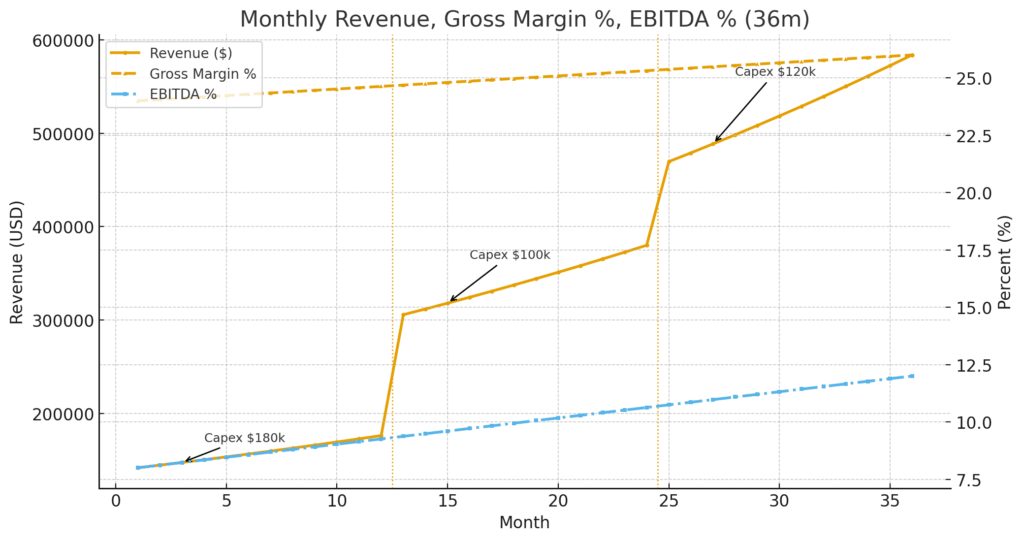
Notes: Year 1 cash is capex-heavy (patrol vehicles, upfit). Year 2 and 3 benefit from operating leverage and improving DSO.
Five-Year Annual Roll-Up (Directional)
| Year | Revenue | Gross Margin % | EBITDA % | Ending Weekly Hours |
|---|---|---|---|---|
| Yr1 | $1.9M | 24% | 8% | 1,000 |
| Yr2 | $4.1M | 25% | 10% | 2,100 |
| Yr3 | $6.3M | 26% | 12% | 3,100 |
| Yr4 | $7.7M | 26% | 13% | 3,700 |
| Yr5 | $9.0M | 27% | 13–14% | 4,300 |
Scenario Testing (Base / Downside / Upside)
| Variable | Downside | Base | Upside |
|---|---|---|---|
| Weekly hours (Yr3) | 2,500 | 3,100 | 3,600 |
| Blended bill rate | $30.00 | $31.00 | $32.00 |
| Blended loaded cost | $25.50 | $24.00 | $23.50 |
| OT % of hours | 12% | 8% | 6% |
| DSO (Yr3) | 42 days | 33 days | 30 days |
| EBITDA % (Yr3) | 6–7% | ~12% | 13–14% |
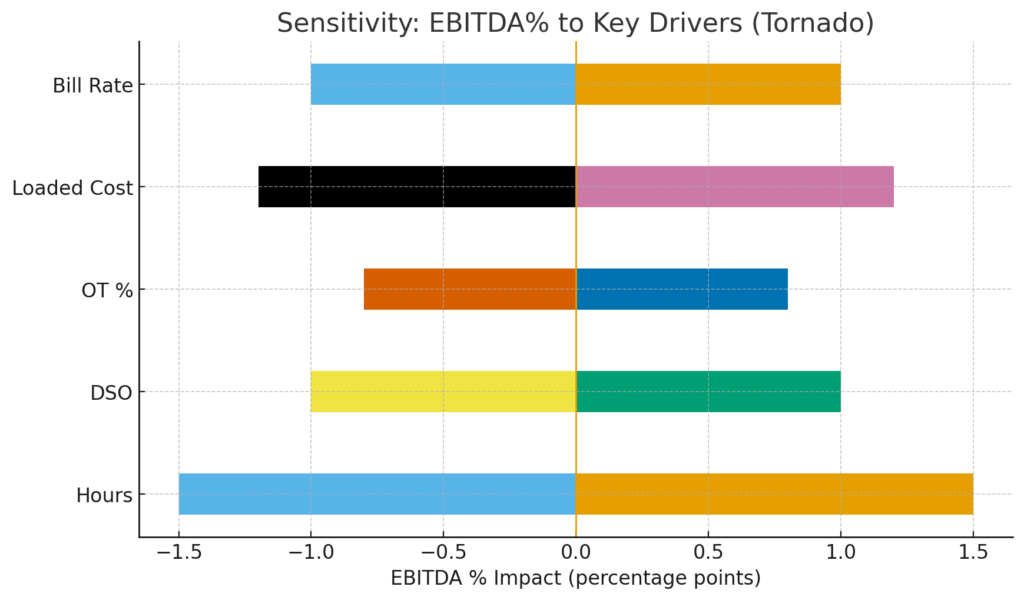
Interpretation: the business is most sensitive to hours and DSO. OT and loaded cost are next. Bill-rate gains help, but discipline on staffing and collections moves EBITDA faster than fancy pricing talk.
AR Policy, Billing & DSO Discipline
Cash gets weird when payroll leads collections by two Fridays in a row. We avoid that with clear intake terms and non-emotional enforcement.
- Billing: weekly timesheets, invoices out by Tuesday 12:00, portal + email delivery.
- Terms: net-30 standard; deposits/retainers on new or event accounts; milestone prepay on large mobilizations.
- Collections: 30-day reminder, 45-day call + credit hold notice, 60-day stop-work trigger with executive review.
- AR monitoring: aging bands (0–15, 16–30, 31–45, 46–60, 60+), DSO trend, and largest tenors reviewed weekly.
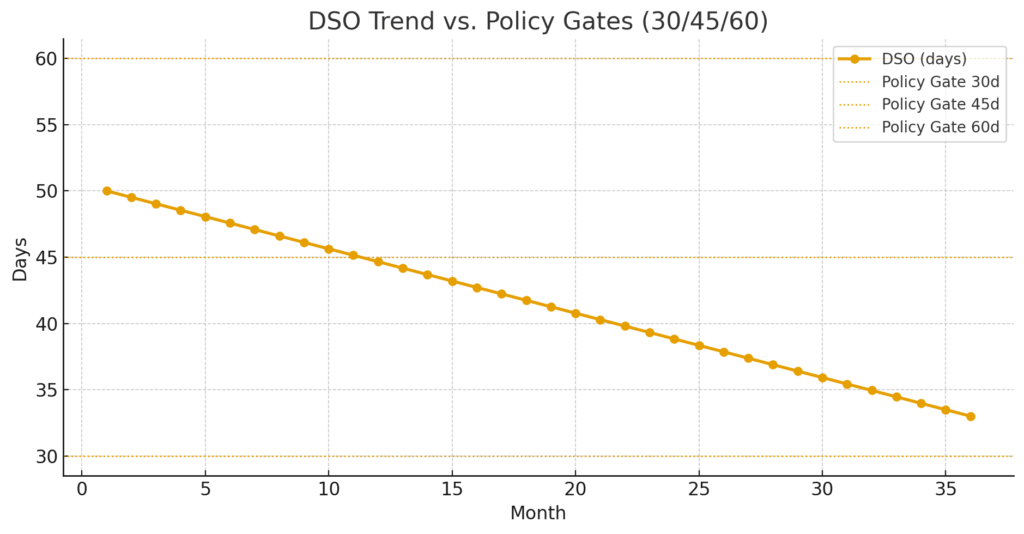

Controls & Accounting (Segregation of Duties)
We structure controls so honest people never have to rely on trust alone. It’s lighter than enterprise SOX, but the spirit is the same.
- Cash receipts: AR posts by Controller; deposits reconciled by CFO; bank recs weekly with independent review.
- Disbursements: three-way match (PO/receipt/invoice); dual approval over $5k; ACH whitelist; vendor master changes logged.
- Payroll: hours approved by Ops; payroll run by HR/Payroll; funding approved by CFO; quarterly payroll audits sampling 10% of shifts against GPS/guard-tour logs.
- Purchasing & fleet: fuel cards with per-vehicle caps; telematics reconciled to fuel usage; assets tagged; quarterly inventory count (gear, uniforms, duty equipment).
- Revenue & cut-off: close on business day 5; unbilled hours report reviewed; credit memos approved by CFO only.
- Compliance files: license/trainings blocked in WFM if expired; quarterly credential audit; incident log tamper-evident exports stored per policy.
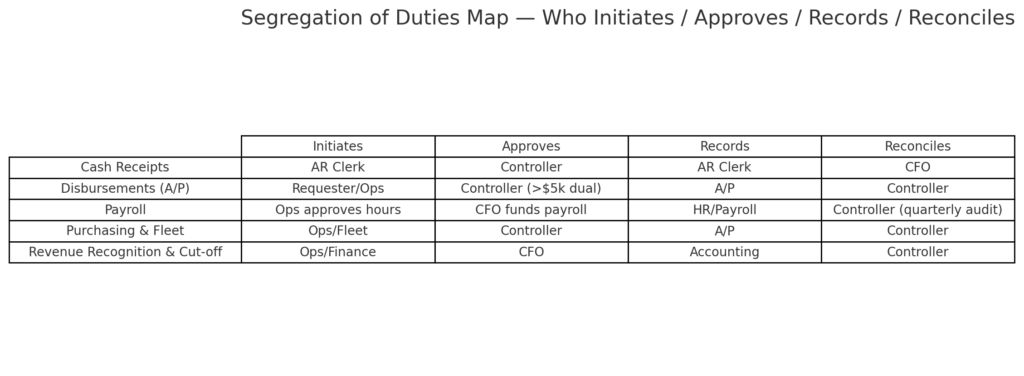
Covenants & Ratios (What We Watch)
| Metric | Target | Why It Matters |
|---|---|---|
| DSCR (debt service coverage) | ≥ 1.25x | Lender comfort; buffers capex and seasonality |
| Gross margin per post | ≥ 22% | Signals pricing & staffing discipline |
| AR > 60 days | < 5% of AR | Working-capital health |
| OT % of total hours | ≤ 8% | Cost containment without starving coverage |
| 90-day retention (new hires) | ≥ 75% unarmed / 85% armed | Margin leak prevention |
Bottom line. The model is only as good as the habits underneath it: schedule discipline to cap OT, pricing tied to loaded cost, weekly AR hygiene, and controls that make fraud hard and mistakes visible. Do those four, and the monthly P&L, CF, and BS tell a calm story investors and banks can underwrite—without us pretending security is anything other than an execution business with tight math.
Funding Ask & Use of Funds
We’re asking for capital sized to the reality of guard payroll leading collections. The instrument can be debt-only or a simple mix; the goal is the same: stand up posts quickly, launch patrols without cash whiplash, and keep margin intact while AR normalizes.
Amount & structure (proposed): $650,000 total — primary path: senior debt with covenant light; alternate path: 80/20 debt–equity split to ease early cash strain.
| Instrument | Amount | Terms (Illustrative) | Rationale |
|---|---|---|---|
| Senior Term Loan | $500,000 | 60 mo.; interest-only 6 mo.; DSCR ≥ 1.25x | Patrol fleet + gear + part of working capital |
| Revolving Line (AR-backed) | $100,000 | Prime + spread; 80% advance on eligible AR | Smooths payroll vs. collections timing |
| Founder/SAFE (optional) | $50,000 | Discount 15%; MFN | Buffer for ramp variance |
Use of Funds (12-Month Ramp)
| Category | Amount | What It Buys | Why It Matters |
|---|---|---|---|
| Payroll Working Capital / AR Float | $350,000 | Two payroll cycles ahead of DSO; deposit policy | Keeps posts staffed while AR ages down |
| Patrol Vehicles (6) + Upfit | $120,000 | Leased or gently used units, lights/marking, telematics | Launches mobile patrol & alarm response |
| Insurance Premia & Collateral | $60,000 | GL, WC, Auto, E&O, Umbrella; broker deposits | Contract-ready COIs from day one |
| Recruiting, Training, Licensing & Gear | $80,000 | Uniforms, duty gear, quals, classroom time | Accelerates time-to-post, protects QA |
| Software Stack & Implementation | $20,000 | Guard-tour, WFM/payroll, LMS, client portal | Live KPIs, fewer billing errors |
| Contingency | $20,000 | Unplanned OT spikes, vehicle repairs | Prevents small issues from becoming cash events |
| Total | $650,000 | — | — |

Cash runway sanity check. At ~1,000 weekly hours in Year 1 and a blended contribution near $7.10/hr, monthly contribution is roughly $30,000. Fixed overhead near $60,000 yields a ~$30,000 operating gap during early months—covered by working capital until hours scale and DSO improves from ~45 to the mid-30s.
Milestones & Draw Schedule
We tie capital to verifiable operating milestones. Tranches are practical: vehicles when patrols go live, recruiting dollars when posts activate, and working capital as AR builds.
| Quarter | Milestone | KPI Target | Draw / Release |
|---|---|---|---|
| Q1 | Licenses bound; 3 standing sites live | Weekly hours ≥ 320; GM/post ≥ 22% | $200k (WC $120k; Insurance $60k; Software $20k) |
| Q2 | Patrol program launch (4 vehicles) | Weekly hours ≥ 600; OT ≤ 8%; DSO ≤ 40 | $160k (Fleet $120k; Recruiting/Gear $40k) |
| Q3 | Scale to 10+ sites; add 2 vehicles | Weekly hours ≥ 800; GM/post ≥ 23% | $140k (WC $100k; Gear/Training $40k) |
| Q4 | Stabilize & prep Year-2 expansion | Weekly hours ≥ 1,000; DSO ≤ 38 | $150k (WC $130k; Contingency $20k) |
Post-funding covenant posture. We operate to lender comfort: DSCR at or above 1.25x by Month 18, AR > 60 days under 5% of total, OT contained at or below 8% of hours, and gross margin per post at or above 22%. If a metric drifts, rate escalators and staffing tweaks kick in before it becomes a cash story.
What investors/banks get. Capital that turns into activated posts, a patrol program that sells itself on visibility, and a working-capital buffer sized to reality. What we deliver back: clean statements, predictable KPIs, and a business that scales without crushing cash—because the use of funds is welded to milestones, not wishes.
KPIs, Risks & Appendices
We manage the business in the open. Clients see the same dashboard we stare at every Monday morning, and we don’t bury bad news in averages. A few numbers tell you if a security company is healthy: incidents per 1,000 guard-hours, response time, overtime, fill rate, gross margin per post, and how fast cash comes home (DSO and AR aging). Everything else is commentary.
KPI Panel
| KPI | Target / Guardrail | How We Measure | Action if Off-Track |
|---|---|---|---|
| Incidents per 1,000 Guard-Hours | ≤ 1.5 (by risk tier) | All incidents logged with type, time, outcome | Root-cause review; adjust patrol frequency/post orders; client note |
| Average Response Time | ≤ 5 min on-site (patrol); ≤ 60 sec acknowledge (standing) | Guard-tour timestamps + GPS | Supervisor escalation; reposition checkpoints; add rover if needed |
| Schedule Fill Rate | ≥ 98% | Roster vs. actual; exceptions flagged daily | Tap relief pool; overtime cap waiver only with Ops approval |
| Overtime % of Hours | ≤ 8% (alerts at 6%) | WFM exports weekly; site & guard level | Rebalance rosters; add hires; client scope talk if chronic |
| Gross Margin per Post | ≥ 22% | Bill vs. loaded cost by site | Rate escalator per contract; redesign staffing; swap equipment |
| DSO (Days Sales Outstanding) | Yr1: 45→38; Yr2: 35; Yr3: 33 | Invoice date to payment cleared | 30/45/60 cadence; deposit on new work; stop-work at 60+ |
| AR Aging > 60 Days | < 5% of AR | Weekly aging bands | Executive call; collections hold; legal if necessary |
| 90-Day Retention (New Hires) | ≥ 75% unarmed / 85% armed | Cohort tracking | Supervisor coaching; attendance micro-bonuses; rework onboarding |
Cadence: weekly exceptions to ops + client contacts; monthly mini-reviews; quarterly QBRs with trend lines and a 90-day action plan. No vanity charts—only numbers we can move.
Risk Register & Mitigation
| Risk | Signal | Mitigation | Owner |
|---|---|---|---|
| Staffing / Absenteeism | Fill rate dips; rising call-offs | Relief pool ≈ 10% of posts; attendance bonuses; cross-training; supervisor nights/weekends | Director of Operations |
| Overtime & Margin Creep | OT > 8%; GM/post < 22% | Roster redesign; add hires; contract escalators tied to cost; lock holiday/OT terms | Ops + Finance |
| Compliance (Licenses, FCRA, OSHA) | Expired creds; audit findings | WFM credential blocks; quarterly audits; documented FCRA steps; OSHA JHAs & drills | Compliance & Training Lead |
| Contract / SCA Exposure | WD changes; scope creep | WD mapping in pricing; change-control; equitable adjustments; rate escalators | Finance + Legal |
| Safety & Liability | Incident spikes; injury trend | After-action reviews; PPE; site controls; rotate high-stress posts; insurance limits/COIs | Ops Manager |
| Collections / Cash | AR>60 rises; DSO stalls | Deposits on new accounts; 30/45/60 playbook; stop-work; AR-backed revolver | Controller |
| Reputation / Client Churn | NPS < 50; renewal risk | Supervisor presence; post-order refresh; exec sponsor calls; quick-win fixes | CEO + CS Lead |
Trigger discipline: each risk has a pre-agreed tripwire (e.g., OT > 8% for two weeks), so we act before it turns into a margin story.
Appendices (What’s Ready on Request)
- Post Orders Template (Redacted Sample) — access rules, patrol routes, escalation, emergency procedures, reporting standards.
- Incident Report Forms — timestamped narrative + photo/video attachments; evidence handling basics.
- Training Syllabus — Level II/III/IV modules, de-escalation, report writing, OSHA elements, refreshers calendar.
- Licensing Matrix — company & officer credentials, renewal dates, multi-state entry requirements.
- Insurance Certificates (COIs) — GL, WC, Auto, E&O, Umbrella; additional insured and waiver language samples.
- SCA / Prevailing Wage Extracts — sample wage determinations, mapping to job classes, accrual worksheets.
- Key Resumes — leadership and field supervisor bios highlighting relevant operations wins.
That’s the toolkit. If a client or lender asks “how do you know you’re on track?”, we don’t hand them adjectives—we show them this panel, the risk tripwires, and the appendices that prove the system underneath the promises.
